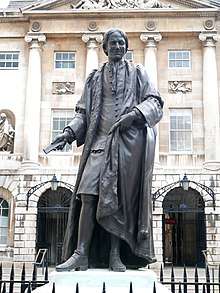Statue of Thomas Guy
A statue of Thomas Guy stands in the forecourt of Guy's Hospital in the borough of Southwark in Central London. The statue is Grade II listed.
| Statue of Thomas Guy | |
|---|---|
 The statue in 2020 | |
| Artist | Peter Scheemakers |
| Completion date | c. 1732 |
| Subject | Thomas Guy |
| Location | London, England |
| Owner | Guy's and St Thomas' NHS Foundation Trust |
Due to Guy's controversial connection with the Transatlantic Slave trade, the statue has come under scrutiny.[1]
History
Thomas Guy was a British member of Parliament, investor and bookseller. He held shares in the South Sea Company. Due to a brief period where the company attempted to sell slaves in Spanish America, he is seen as a controversial figure.
The bronze statue was cast by Peter Scheemakers between 1731 and 1734.[2]
In June 2020, during the George Floyd protests in the United Kingdom following the killing of George Floyd in Minneapolis, Minnesota, many controversial statues became the target of attacks and scrutiny. The Mayor of London Sadiq Khan established the Commission for Diversity in the Public Realm in order to review statues and monuments in the city. The Guy's and St Thomas' NHS Foundation Trust announced that they would work with Khan on the issue. The Statue was boarded up on June 12. As of August 10th, 2020 the statue remains covered.[3][4]
See also
References
- "Black Lives Matter: Statue to Guy's Hospital founder could be torn down over slavery links". Southwark News. Retrieved 11 June 2020.
- "STATUE OF THOMAS GUY IN COURTYARD OF GUYS HOSPITAL, PEDESTAL AND RAILINGS, Southwark – 1385879 | Historic England". historicengland.org.uk. Retrieved 11 June 2020.
- team, London SE1 website. "Future of Thomas Guy statue in question as slavery row grows". London SE1. Retrieved 11 June 2020.
- "Guy's Hospital considers taking down controversial statue of businessman who profited from slavery". ITV News. Retrieved 11 June 2020.
Further reading
- Dresser, Madge (1 October 2007), "Set in Stone? Statues and Slavery in London", History Workshop Journal, 64 (1), pp. 162–199, doi:10.1093/hwj/dbm032, JSTOR 25472939